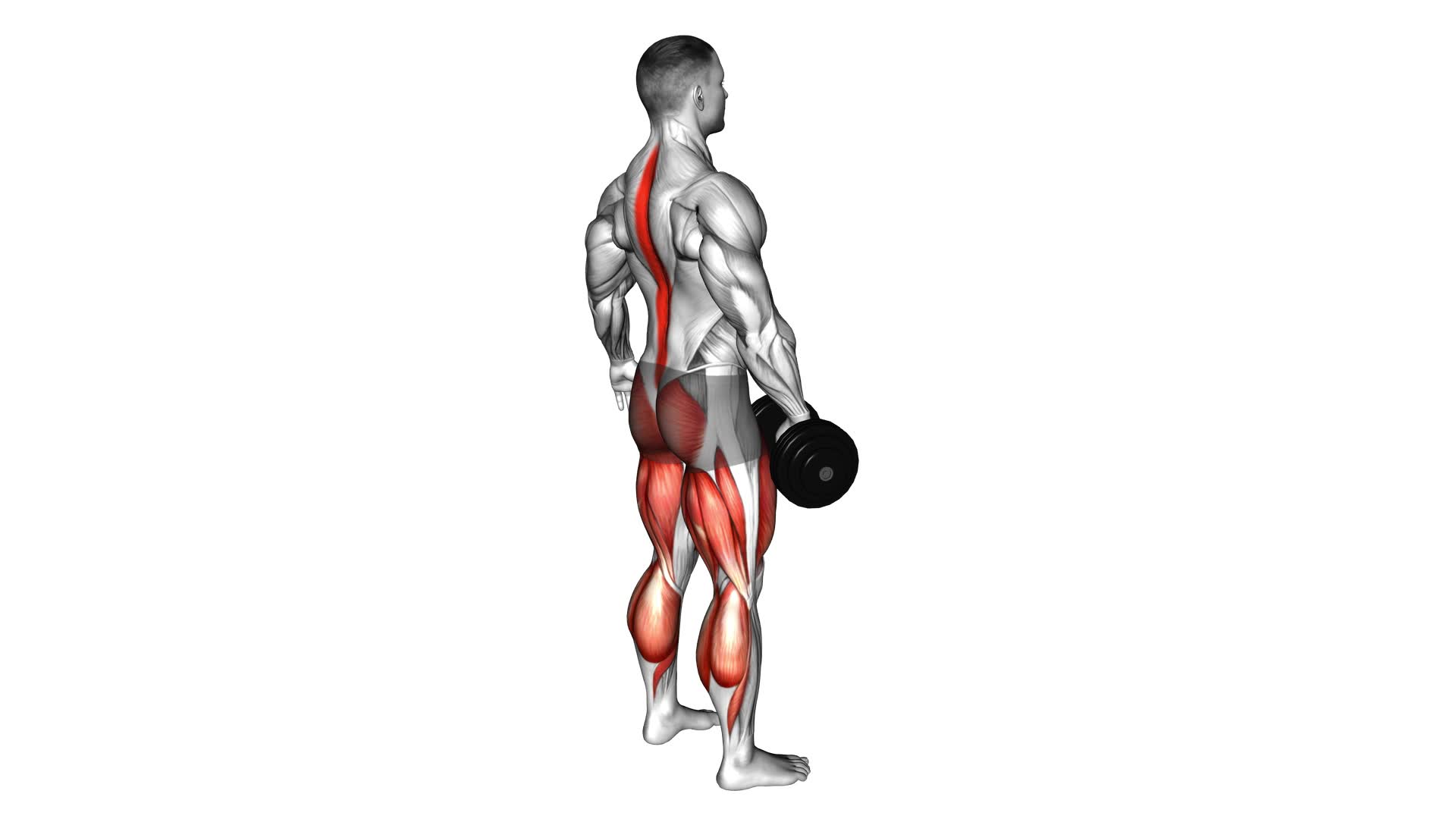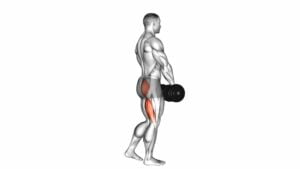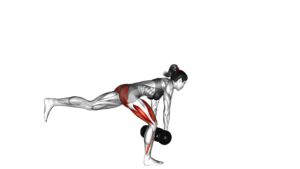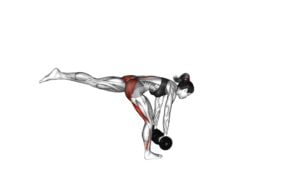Dumbbell Single Arm Deadlift – Video Exercise Guide & Tips

Are you looking for a challenging and effective exercise to incorporate into your workout routine? Look no further than the dumbbell single arm deadlift.
Watch This Exercise Video
This exercise targets multiple muscle groups and is a great way to improve strength and stability.
In this video exercise guide, you'll learn the proper form and technique, as well as the benefits and common mistakes to avoid.
Get ready to take your fitness to the next level with this expert-approved exercise.
Let's get started!
Key Takeaways
- Proper form and technique are crucial for performing the dumbbell single arm deadlift effectively and safely.
- The exercise helps improve grip strength and addresses muscle imbalances through unilateral training.
- Engages multiple muscle groups including the glutes, hamstrings, quadriceps, and core for enhanced strength and stability.
- To maximize results, it is important to use proper technique, gradually increase weight, and maintain a balanced nutrition and consistent workout schedule.
Proper Form and Technique
To perform the Dumbbell Single Arm Deadlift with proper form and technique, start by standing with your feet hip-width apart and a dumbbell in one hand. This exercise not only targets the muscles in your legs and back but also helps improve grip strength and muscle activation patterns.
To begin, hinge at your hips and lower the dumbbell towards the ground while keeping your back straight and core engaged. Make sure to maintain a neutral spine throughout the movement. As you lower the weight, focus on keeping your shoulders squared and your chest lifted.
Next, drive through your heels and extend your hips to stand back up, squeezing your glutes at the top of the movement. Keep your arm straight as you lift the weight, using your leg and hip muscles to generate the power.
It's important to keep the weight close to your body throughout the exercise to maintain balance and stability. Avoid twisting or rotating your torso as you lift the dumbbell.
Remember to breathe consistently throughout the movement and maintain control over the weight at all times.
Benefits of the Dumbbell Single Arm Deadlift
The dumbbell single arm deadlift offers several benefits for your body and overall fitness. One of the key benefits is improved grip strength. Since you're using only one arm to lift the dumbbell, your grip has to work harder to maintain control throughout the movement. This can help strengthen your forearm muscles and improve your ability to hold onto objects in your daily life.
Another benefit of the dumbbell single arm deadlift is unilateral training. Unilateral exercises focus on training one side of the body at a time, which can help to address any muscle imbalances or weaknesses. By performing this exercise with one arm at a time, you can identify and correct any asymmetries in strength or mobility.
In addition, the dumbbell single arm deadlift engages multiple muscle groups, including the glutes, hamstrings, quadriceps, and core. It can help to improve overall strength and stability in these areas, which can translate to better performance in other exercises and activities.
To maximize the benefits of the dumbbell single arm deadlift, it's important to use proper form and technique. Keep your back straight, engage your core, and lift the dumbbell with controlled movements. Start with a lighter weight and gradually increase as you become more comfortable and confident with the exercise.
Remember to always consult with a fitness professional before starting any new exercise routine.
Common Mistakes to Avoid
When performing the dumbbell single arm deadlift, be cautious of the common mistakes that can hinder your progress. To ensure that you're executing the exercise correctly and maximizing its benefits, pay attention to the following:
- Using improper form: One of the most common mistakes is using improper form during the dumbbell single arm deadlift. This can lead to ineffective muscle activation and potential injury. Make sure to keep your back straight, engage your core, and hinge at the hips while maintaining a neutral spine.
- Lifting too heavy: Another mistake to avoid is lifting a weight that's too heavy for you. This can compromise your form and prevent you from performing the exercise with proper technique. Start with a weight that challenges you but allows you to maintain control and stability throughout the movement.
- Neglecting the mind-muscle connection: It's crucial to focus on the mind-muscle connection during the dumbbell single arm deadlift. This means intentionally engaging the muscles you're targeting, such as the hamstrings, glutes, and lower back. By doing so, you'll optimize your results and reduce the risk of relying on compensatory muscles.
By avoiding these common mistakes and practicing proper technique, you can effectively perform the dumbbell single arm deadlift and achieve your fitness goals.
Now, let's explore some variations and progressions of this exercise to continue challenging yourself and making progress.
Variations and Progressions
Now, let's explore some ways you can challenge yourself and make progress with variations and progressions of the dumbbell single arm deadlift. To take your workout to the next level, you can incorporate advanced techniques and focus on muscle activation.
One variation you can try is the deficit single arm deadlift. This involves standing on a raised surface, such as a step or block, while performing the exercise. By increasing the range of motion, you engage your muscles more intensely and enhance muscle activation.
Another progression is the single arm deadlift with a kettlebell. Using a kettlebell instead of a dumbbell adds an extra challenge due to its unique shape and weight distribution. This variation requires increased stability and coordination, making it an excellent choice for those looking to further strengthen their core and improve overall balance.
To further challenge yourself, you can try the single arm deadlift with a resistance band. This variation adds resistance throughout the entire movement, forcing your muscles to work harder. It also helps to improve grip strength and stability.
Tips for Maximizing Results
To maximize your results with the dumbbell single arm deadlift, focus on proper form and gradually increase the weight as you become stronger. Here are three tips to help you achieve the best possible results:
- Maintain a balanced nutrition:
Fueling your body with the right nutrients is crucial for maximizing your workout results. Make sure to consume a well-rounded diet that includes lean proteins, complex carbohydrates, and healthy fats. Additionally, stay hydrated by drinking plenty of water throughout the day.
- Follow a consistent workout schedule:
Consistency is key when it comes to seeing progress. Establish a regular workout routine that includes the dumbbell single arm deadlift and other exercises targeting different muscle groups. Aim for at least three to four days of strength training per week, allowing for adequate rest and recovery days.
- Gradually increase the weight:
As you become stronger and more comfortable with the exercise, gradually increase the weight of the dumbbell. This progressive overload will challenge your muscles and stimulate growth. Start with a weight that allows you to perform the exercise with proper form and gradually increase the resistance as you build strength.
Frequently Asked Questions
How Many Sets and Reps Should I Do for the Dumbbell Single Arm Deadlift?
To determine the number of sets and reps for the dumbbell single arm deadlift, consider your fitness level and goals.
Beginners may start with 2-3 sets of 8-12 reps per arm.
As you progress, increase the weight and decrease the reps to 4-6 per arm for strength gains.
To add variation, try using different grips or incorporating other exercises like the dumbbell single arm row or Romanian deadlift.
Always consult a fitness professional for personalized advice.
Can I Use a Kettlebell Instead of a Dumbbell for This Exercise?
Yes, you can absolutely use a kettlebell instead of a dumbbell for the single arm deadlift. Kettlebells offer unique benefits for this exercise, such as increased grip strength and stability.
They also engage more muscles, including the core and glutes.
Is the Dumbbell Single Arm Deadlift Suitable for Beginners?
Proper form is crucial for the dumbbell single arm deadlift. It's essential, especially for beginners, to focus on maintaining a neutral spine and engaging the core muscles.
Some common mistakes to avoid include rounding the back, lifting the weight too quickly, and not using the hips to drive the movement.
What Muscles Does the Dumbbell Single Arm Deadlift Target?
The dumbbell single arm deadlift is a great exercise to target multiple muscles in your body. By incorporating this exercise into your workout routine, you can reap numerous benefits.
It primarily targets your glutes, hamstrings, and lower back muscles, while also engaging your core for stability. To perform this exercise properly, make sure to maintain a neutral spine, hinge at your hips, and keep your shoulders square.
This exercise is an effective way to strengthen and tone your lower body.
Can I Incorporate the Dumbbell Single Arm Deadlift Into a Full-Body Workout Routine?
Incorporating dumbbell single arm deadlifts into a full body workout routine can be a great way to target multiple muscle groups and increase overall strength. This exercise works your glutes, hamstrings, lower back, and core.
To make it more challenging for advanced lifters, you can try variations like the single-arm dumbbell Romanian deadlift or the single-arm dumbbell sumo deadlift. These variations require more stability and engage additional muscles, making your workout more effective.
Conclusion
In conclusion, the dumbbell single arm deadlift is an effective exercise for building strength and improving overall fitness. By maintaining proper form and technique, you can target multiple muscle groups, including the legs, core, and back.
Avoiding common mistakes and gradually progressing with variations will ensure optimal results. Remember to follow the tips provided to maximize your workout and achieve your fitness goals.
Keep pushing yourself and enjoy the benefits of this challenging exercise.

Author
Years ago, the spark of my life’s passion ignited in my mind the moment I stepped into the local gym for the first time. The inaugural bead of perspiration, the initial endeavor, the very first surge of endorphins, and a sense of pride that washed over me post-workout marked the beginning of my deep-seated interest in strength sports, fitness, and sports nutrition. This very curiosity blossomed rapidly into a profound fascination, propelling me to earn a Master’s degree in Physical Education from the Academy of Physical Education in Krakow, followed by a Sports Manager diploma from the Jagiellonian University. My journey of growth led me to gain more specialized qualifications, such as being a certified personal trainer with a focus on sports dietetics, a lifeguard, and an instructor for wellness and corrective gymnastics. Theoretical knowledge paired seamlessly with practical experience, reinforcing my belief that the transformation of individuals under my guidance was also a reflection of my personal growth. This belief holds true even today. Each day, I strive to push the boundaries and explore new realms. These realms gently elevate me to greater heights. The unique combination of passion for my field and the continuous quest for growth fuels my drive to break new ground.



